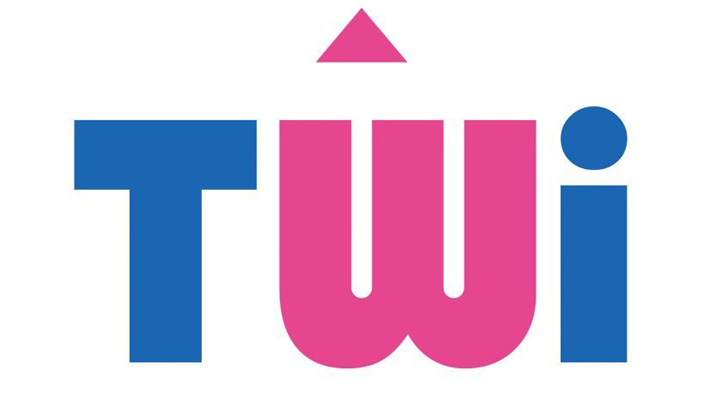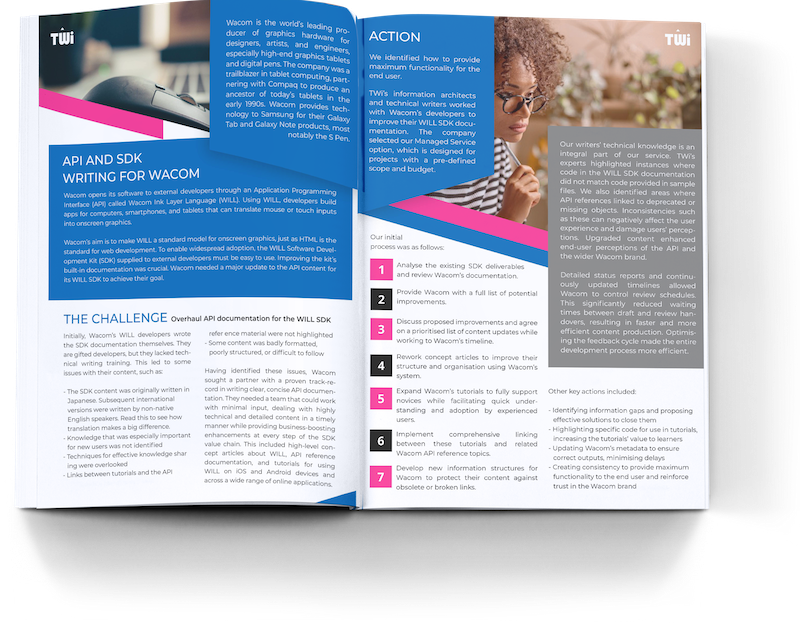API DOCUMENTATION
WACOMClarity and consistency to benefit the SDK end-user.
Introduction
How we developed content optimised for their business needs and for the needs of their users.
WACOM needed a team that could work with minimal input, dealing with highly technical and detailed content in a timely manner while providing business-boosting enhancements at every step of the SDK value chain.
TWi quickly understood how our internal documentation generation tools work. They proactively made suggestions to enhance our HTML tools for previewing the SKD content. which we implemented.
Branimir Angelov, System Architect,
Wacom Europe GmBH
WACOM: Clarity and consistency to benefit the SDK end-user
Wacom is the world’s leading producer of graphics hardware for designers, artists, and engineers, especially high-end graphics tablets and digital pens. The company was a trailblazer in tablet computing, partnering with Compaq to produce an ancestor of today’s tablets in the early 1990s. Wacom provides technology to Samsung for their Galaxy Tab and Galaxy Note products, most notably the S Pen.
API AND SDK WRITING FOR WACOM
Wacom opens its software to external developers through an Application Programming Interface (API) called Wacom Ink Layer Language (WILL). Using WILL, developers build apps for computers, smartphones, and tablets that can translate mouse or touch inputs into onscreen graphics.
Wacom’s aim is to make WILL a standard model for onscreen graphics, just as HTML is the standard for web development. To enable widespread adoption, the WILL Software Development Kit (SDK) supplied to external developers must be easy to use. Improving the kit’s built-in documentation was crucial. Wacom needed a major update to the API content for its WILL SDK to achieve their goal.
THE CHALLENGE: OVERHAUL API DOCUMENTATION FOR THE WILL SDK
Initially, Wacom’s WILL developers wrote the SDK documentation themselves. They are gifted developers, but they lacked technical writing training. This led to some issues with their content, such as:
-
-
-
- The SDK content was originally written in Japanese. Subsequent international versions were written by non-native English speakers. Read this to see how translation makes a big difference.
- Knowledge that was especially important for new users was not identified
- Techniques for effective knowledge sharing were overlooked
- Links between tutorials and the API reference material were not highlighted
- Some content was badly formatted, poorly structured, or difficult to follow
-
-
Having identified these issues, Wacom sought a partner with a proven track-record in writing clear, concise API documentation. They needed a team that could work with minimal input, dealing with highly technical and detailed content in a timely manner while providing business-boosting enhancements at every step of the SDK value chain. This included high-level concept articles about WILL, API reference documentation, and tutorials for using WILL on iOS and Android devices and across a wide range of online applications.
THE ACTION: TWI IDENTIFIED HOW TO PROVIDE MAXIMUM FUNCTIONALITY FOR THE END USER
TWi’s information architects and technical writers worked with Wacom’s developers to improve their WILL SDK documentation. The company selected our Managed Service option, which is designed for projects with a pre-defined scope and budget.
Our initial process was as follows:
-
-
-
- Analyse the existing SDK deliverables and review Wacom’s documentation.
- Provide Wacom with a full list of potential improvements.
- Discuss proposed improvements and agree on a prioritised list of content updates while working to Wacom’s timeline.
- Rework concept articles to improve their structure and organisation using Wacom’s system.
- Expand Wacom’s tutorials to fully support novices while facilitating quick understanding and adoption by experienced users.
- Implement comprehensive linking between these tutorials and related Wacom API reference topics.
- Develop new information structures for Wacom to protect their content against obsolete or broken links.
-
-
Our writers’ technical knowledge is an integral part of our service. TWi’s experts highlighted instances where code in the WILL SDK documentation did not match code provided in sample files. We also identified areas where API references linked to deprecated or missing objects. Inconsistencies such as these can negatively affect the user experience and damage users’ perceptions. Upgraded content enhanced end-user perceptions of the API and the wider Wacom brand.
Detailed status reports and continuously updated timelines allowed Wacom to control review schedules. This significantly reduced waiting times between draft and review handovers, resulting in faster and more efficient content production. Optimising the feedback cycle made the entire development process more efficient.
Other key actions included:
-
-
-
- Identifying information gaps and proposing effective solutions to close them
- Highlighting specific code for use in tutorials, increasing the tutorials’ value to learners
- Updating Wacom’s metadata to ensure correct outputs, minimising delays
- Creating consistency to provide maximum functionality to the end user and reinforce trust in the Wacom brand
-
-
THE IMPACT: INCREASED CLARITY, QUALITY, EFFICIENCY, AND FUNCTIONALITY
TWi’s project enhancement for Wacom resulted in:
-
-
-
- Increased external adoption of the WILL API thanks to improved SDK documentation
- Improved quality, structure, styling, and formatting of content
- Effective project management
- Knowledge that was optimised to be accessible to all users
- Greater consistency
- More user-friendly tutorials directly linked to relevant API content
- Improved data sharing
-
-
The client appreciated the efficiency generated by TWi’s client-communication methodology. The WILL SDK developers were impressed with our initiative in flagging technical issues and ability to carry out constructive changes and updates without their input.
Following our engagement, Wacom extended the project’s scope. Phase 2’s expanded targets and criteria were based around TWi’s ability to provide content optimised for their business needs and for the needs of their users.
THE CLIENT’S PERSPECTIVE:
“TWi’s assistance proved invaluable. They quickly got to grips with the technical nature of the material and took a fresh look at everything we had. The content is now structured and clear, and its usability has been greatly enhanced. TWi quickly understood how our internal documentation generation tools work. They proactively made suggestions to enhance our HTML tools for previewing the SDK content, which we implemented. We’re very happy and are planning to work with TWi on future documentation projects.”
– Branimir Angelov, System Architect, Wacom Europe GmBH
Related Insights
Start your content transformation today.

